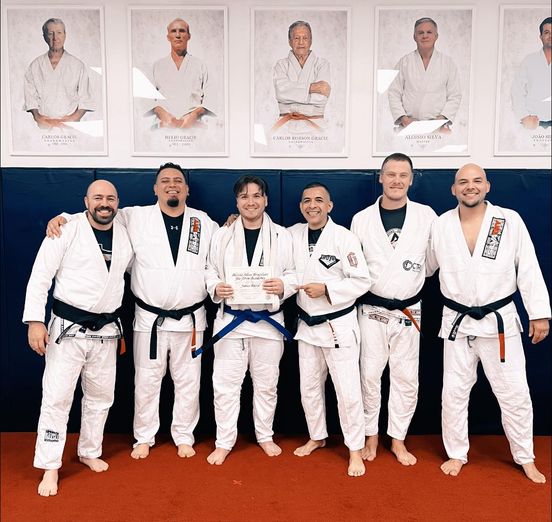
“Promotions”
The age-old question arises every so often…what does it take to be promoted? Receiving a stripe or the highly-anticipated belt promotion is an exciting celebration for everyone. Instructors and students may have varying thoughts and expectations about when someone is ready to be promoted. Below are my thoughts about this question.
I believe it should never be a guessing game and that the standards for promotion are clearly communicated. I do my best to convey my thoughts, standards and expectations, and today I decided to express these thoughts in writing.
Following are factors that I consider when determining whether or not a student is ready to be promoted:
1. Tenure – How long has a student been training and in their current rank? I do my best to follow the guidelines established by the Federations, with very few warranted exceptions. For example: a student has been training for X period of time. This determines eligibility. This is a minimum standard, but other factors may influence this requirement.
2. Consistency – How often does a student train (how often do they share the mats with me)? Just because someone has been a student or a rank for X number of years, it carries a lot less weight if they show up once a month. Sometimes life, injuries, responsibilities, etc. limit training time and that is OK. That student’s journey to the next belt will likely take a little longer than a consistent practitioner.
3. Effort – Showing up for class is simply just not enough! Does the student put in quality mat time? Do they show up for warm-ups? Do they drill with purpose? How many rounds do they roll? Who does the student roll with? Are they challenging themselves with seasoned practitioners, or cherry-picking someone way below their skills set or weight, or with whom they have an age gap advantage, etc.
4. Technical knowledge – Does the student have a basic understanding of all the basic positions, offensively and defensively? As one’s rank increases so should their technical knowledge. Can they break down movements, and articulate the learnings? Do they work only on moves that they like? Or do they branch off from this and continue to develop a well-rounded skills set? Side note…two students may start on the same date, put equal amount of mat time/effort and still develop their skills set and technical knowledge at a different rate. Every student is graded individually and I never follow a cookie-cutter approach.
5. Practical application – How well does the student execute technique? Have they earned their rite of passage into the next rank? Can they take their rank and represent it well anywhere in the world? Are they an X belt who still struggles with their peers who wear the same rank (or are a lower rank)? Does the student dominate most rolling session in their current rank and are starting to seriously challenge those above them? The reality is that a new belt is “heavy,” and the student must be able to carry that load and transition into it with relative ease. If they are presently unable to do this, it’s OK…their journey in X belt will just take a little longer with me. Side note…Getting the best of a higher belt doesn’t warrant a promotion. You are not getting X belt because you tapped X belt.
6. Bushido – As a student moves into the senior ranks, he or she must ask themselves, “Am I good at martial arts, or am I good for martial arts—or both?” As one’s rank increases, so does their leadership in the Dojo. Like it or not, lower-ranking students will migrate toward the upper belt, and they emulate them (in both technique and character). Is the student an honorable ambassador for the art, the Dojo, and their lineage?
7. Experience – Students with prior experience come to train with me. I always take this previous experience into consideration—whether it’s BJJ, Judo, wrestling, sambo—I consider that this individual is not a true white belt, and therefore they may initially move up a little faster.
8. Batsugun: “Instant Promotion” – Students may have witnessed podium promotions before. If a student decides to step into the competition arena and they do well, they will likely move up a little faster in my Dojo. It is my job to continue to challenge my students, rather than allowing them to collect endless gold medals in the same division for an excessive period of time.
9. Brown/Black Belt – I always discuss promotion of students to these ranks with my Professor/ Master/Lineage. I am a part of an organization and an art that is greater than myself. They may agree with my recommendation to promote a student, or they may have additional requirements. I always do the right thing and reach out to them for their blessing.
This list outlines most of my thoughts, standards, and feelings on rank promotions; however, it is not all-encompassing. There are always unique situations (X factors) that have to be taken into consideration. I don’t take the practitioner’s (or parents’) “feelings” into consideration, and what they think the student deserves. Nor do I charge a monetary price for stripes or belts. Belts are “always earned, never given,” and most definitely never sold. Not everyone will see things the way that I do, and that is also OK. There are always options for everyone…seeking an instructor with lower standards is one of them. Or, the student can keep training until they have earned their rite of passage. Or…winning a stacked division (not a 2-3 man bracket) at Pan-Ams or Worlds will most likely help expedite things.
In closing, I want to leave you with some final thoughts. “The New Rank,” as gratifying as it may seem…don’t let it be your “everything.” This journey is so much more than a two-inch wide belt. Think of the positive impact you’re having on your health; think of your endurance—where it was and where it is today; think of the protection your skills provide you and your loved ones in a real-world scenario; think of the goals you have accomplished so far; think of all the techniques you have learned; think of the practitioner you were on day one and how much you have learned about yourself; think of all those “aha” moments when things started to click; think of all the challenges and hurdles you have overcome; think of the times you came to the Dojo beaten up by the world and left refreshed; think of all the friendships you made in the Dojo; think of all the smiles and laughs you had on the mats; think of all the people who helped you on your journey and the ones you have helped. Think of all the amazing experiences you have had and the amazing ones yet to come! That tangible wrapped around our waist feels amazing when it is earned, but don’t “tunnel vision” on it. “When you forget about the belt, it will come.” Control your controllables, trust the process, and trust that I have your best interests in mind on your journey. Don’t fall victim to this wise old saying “I can’t see the forest because of the trees” or however that saying goes…lol. Have a blessed day and see ya’ll in the Dojo. God bless!
-Coach Flores
